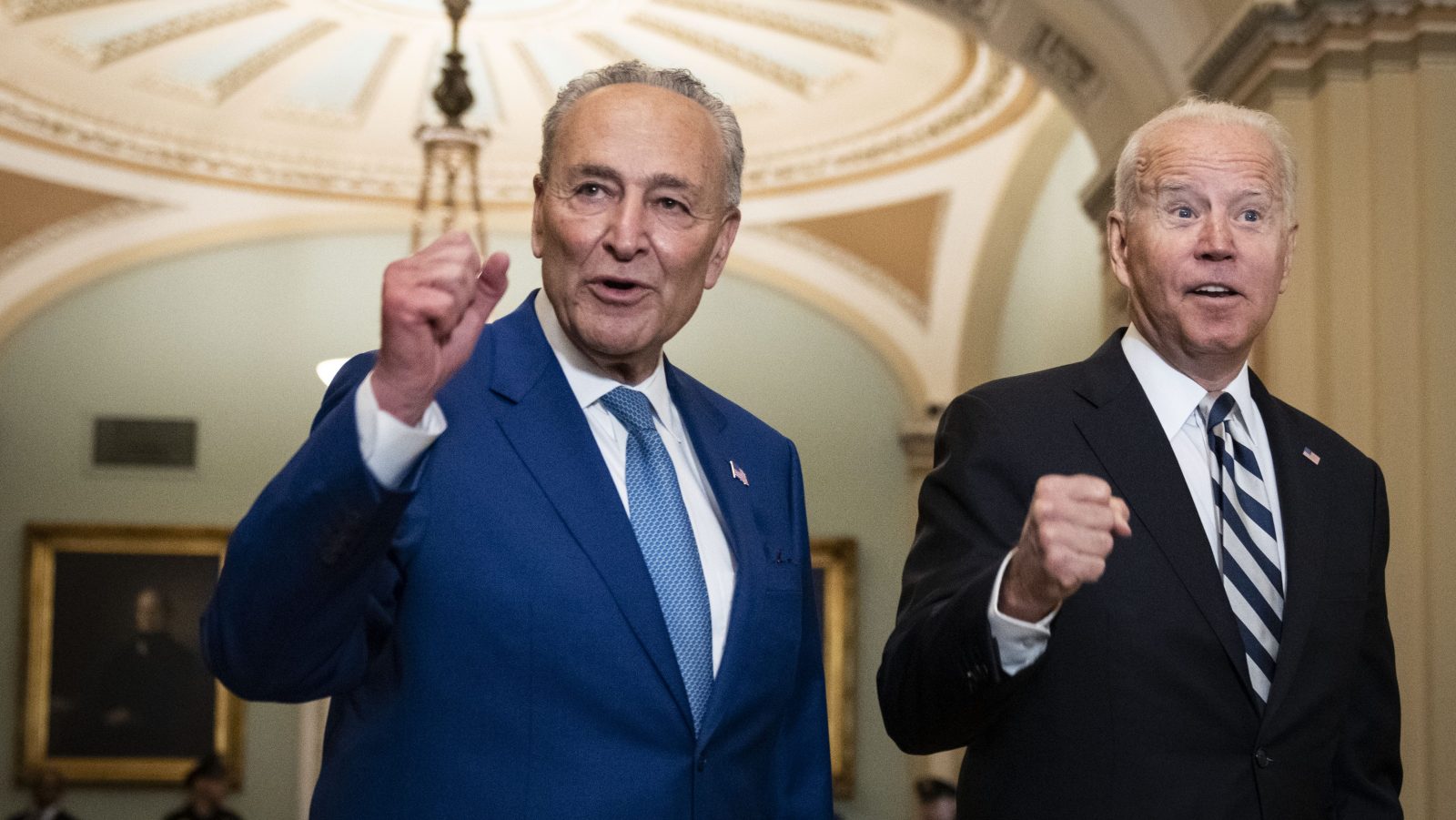President Joe Biden came into office brandishing an ambitious agenda. Then he ran headfirst into the impenetrable political wall that is the U.S. Senate.
Biden’s $2 trillion climate and infrastructure plan, the crown jewel of his first-term agenda, endured months of negotiations before a bipartisan group of centrist senators whittled it into a version that they could accept. The now-$600 billion deal would still be a major investment in American infrastructure, but it doesn’t resemble Biden’s initial vision, which would have accelerated the transition to a low-carbon economy in the U.S. and invested serious resources in green jobs. But Biden promised he wasn’t abandoning his climate mandate. “I’m not just signing the bipartisan bill and forgetting the rest of it,” Biden assured the progressive faction of his party in June.
Late Tuesday night, Senate Democrats moved “the rest of it” a step forward. Senate Majority Leader Chuck Schumer, Senator Bernie Sanders of Vermont, and other Democrats on the Senate Budget Committee announced that they aim to pass the rest of Biden’s agenda — all of the climate and social policies that didn’t make it into the $600 billion infrastructure deal — in a $3.5 trillion budget reconciliation bill. Budget reconciliation is a process that allows Senators to bypass the filibuster — the arcane procedure that allows the minority to block bills that don’t have 60 votes — and to pass spending and tax measures with a simple majority.
Deciding on a spending limit that moderates and progressives could agree on was the easy part. The hard part will be negotiating the specifics of the package, which are still forthcoming.
The climate policies included in the spending plan may center around something called a clean electricity standard, or CES, which is a statutory mandate to reach a renewable electricity generation target by a certain date. The standard, according to Democratic lawmakers and legislative aides, aims to slash emissions 50 percent in the electricity sector by 2030. The standard would require the U.S. to get 80 percent of its electricity from clean sources by 2030, too.
Decarbonizing the electricity sector is relatively low-hanging fruit. The way that the U.S. has made the most progress on cutting carbon so far has been through the electricity sector, with steps like retiring coal-fired plants, putting emissions controls on natural gas power plants, and adding wind and solar to the grid. Even so, power is the second-largest source of greenhouse gas emissions in the U.S. by sector, right behind transportation. And the U.S. will require even more electricity to power the electric vehicles and electric appliances needed to replace the kinds that run on fossil fuels.
But there are about a thousand moving pieces that might make it difficult to pass a clean electricity standard. For one, conservative Democrat Joe Manchin of West Virginia doesn’t like it. “I know they have the climate portion in here, and I’m concerned about that,” Manchin told CNN on Wednesday. If Manchin doesn’t get on board with a CES, it’s dead in the water, since Democrats must ultimately get all 50 senators in their party to vote for the bill in order for it to pass. What’s more, it’s not clear whether the Senate parliamentarian, the person who decides whether something can or cannot be included in a budget reconciliation bill, will allow Democrats to include a CES in there.
“I don’t think you can reasonably argue that regulations that limit emissions or change car standards or anything like that are budget germane,” Marc Goldwein, head of policy at a nonprofit called the Committee for a Responsible Federal Budget, told Grist in February.
There are ways to tailor a clean energy standard to make it budget-relevant and fit the reconciliation mold. Democrats could incorporate the CES into the tax system by taxing certain percentages of electric utilities’ carbon-emitting generation. They could propose creating a carbon trading program within the federal government that companies can tap into to become more climate-friendly. And it’s worth noting that the CES isn’t the only climate measure under consideration. Democrats are also hoping to include funding for a “Civilian Climate Corps,” similar to Franklin Delano Roosevelt’s Civilian Conservation Corps but for jobs in climate resiliency, conservation, and other green industries. They may try to tie in money to expand existing clean energy and electric vehicle tax credits, funding to weatherize and electrify buildings, and more. In the House, where Democrats have a wider majority, progressives will likely try to tack on more climate-related amendments.
“We’re probably still only about a fifth of the way through this process, but one of the most important thresholds was what’s the top line and what’s the commitment to climate?” Democratic Senator Brian Schatz from Hawaii told reporters on Wednesday. “And I feel very good.”




